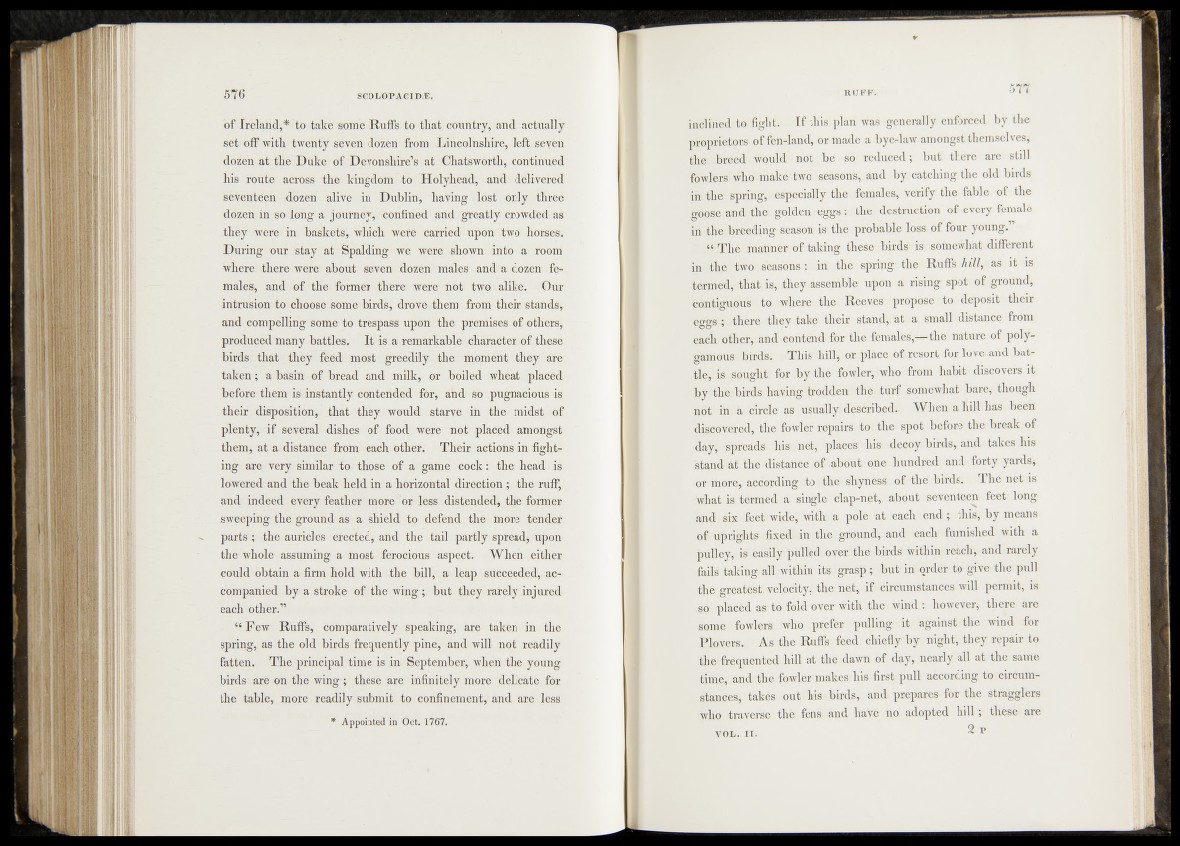
Mr Irelahd-,*:to take some Ruffs to that: country, and actually
set off with twenty seven; dozen from Lincolnshire, left seven
dozen at the Duke of Devonshire’s -at 6hatsworth, continued
ins "route >across. the kihgdorip5o Holyhead, and1 • delivered
se-vendem ^Hibzen aMve^in Dublin, having jpfst r-only three
dozen iff s.o.Tôhg > j ourn^^ eonfined anff 'greatly crowd'edas
they were; in baskets, which were carried upon two'ih’orsesi
During ~our b ta y at Spalding «We. were shown $&&> a- room
where there were about -âéven dozen males and a-dozem-fe-^
males; end of the-former there were not- two alike. Our
intrusion to choose some birds, drove4 them fi?om their stands,
and compelling some to trespass upon the- premises of-ot'hers;
produced many battles. I t is a remarkable > character, inf. these
birds that-they feed most greedily; the- mqmênt,they- are
taken ; a basîïr of bread and milk, or'boiled-wheat placed
before them-; is instantly contended for, and so ' pugnacious is
their disposition, that they would starve, in the .‘midst of
plenty, if several dishes of food were not placed amongst
them, at a distance from each-other. Their :actions in fight-«
ing are very similar to those of a game cock : the, head, is
lowered and5 the beak held in a horizontal direction the ruff,
and indeed every feather more or less, distended, the former
.sweeping the“’ground as a shield to def&pfd the more tender
parts ; the auricles erected, and the tail partly spread, upon
the whole assuming a most ferocious aspect« When either
could obtain a firm hold with the bill, a leap succeeded, accompanied
by a stroke of the wing ; but they rarely injured
each other.”
- V Few Ruffs, comparatively speaking, are taken in the
spring, as the old birds frequently pine, and will nojk readily
fatten. The principal time is in September, when the young
birds are on the wing ; these are infinitely more delicate for
the table, more readily submit to confinement, and are less
Äpßoiatediü Öcti 1767.
inclined to fight. If this plan was generally enforced by the
pMprretprs ofden-land, or made a bye-law amongst themselves,
thei breed would not be so reduced; but there are still
fowlers' whdfem&ke two seasons, and by catching the old birds
in the: spring,,'especially the females, verify the fable of the
ghese and tWgoldfem eggs-: the destruction of every female
in dhfibieeding season is the probable loss of four young.
Thé; manner óf taking; these, birds is somewhat different
inlilhmsiteoK'sbasÓBs: in the spring the Ruffs hill, as it is
termed,-- that- fof/they^assembtei upon a rising spot of ground,
cant£güóuscto;»wl‘éE%Kthe Reeves propose to deposit their
M ÜM there the»take'-their stand,■ 'y&w* • i*'' at a small distance fro_m
each,,'other, anèbontend for the females,-^the nature of polygamousÉbbds.
< This hill, orplace.of resort for love and bat-
is®sought! föhlbydhe fowler^ who from habit discovers it
’feyltkbbirds having^roddmi^the turf somewhat bare, though
Aii’ in a: ’circle. as usually described. When a liill has been
discovered,” the fowler repairs to the spot before the break of
day,-:spreadsdhis net, places: his decoy birds, and takes his
stand at the distance of about one* hundred and forty yards,
or more;!- acöording$t@ ;the’ shynéss' of the birds. The net is
whahis termed a single èlap-net, about seventeen feet long
and sik feet wide, with a p;ole;at each end; this, by means
of uprights fixed; in the ground, and each furnished with a
pulley, is easily pulled "over the: birds within reach, and rarely
fails faKiffi^%l^within its grasp; but in order to give the pull
the greatest velocity,f the net, if circumstances will permit, is
';t|o ' placed as to fold ovfer with the wind : however, there are
some I fowlers who prefer pulling it against the wind for
Plovers. As the Ruffs feed chiefly by night, they repair to
the frequented hill at the dawn of day, nearly all at the same
time, and thé fowler makes his first pull according to circumstances;
takes but his birds, and prepares for the stragglers
Who traverse the fens and have no adopted h ill; these are
VOL. I I . 2 p